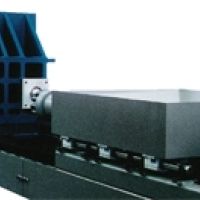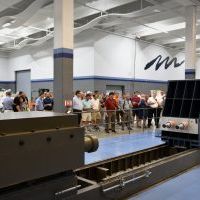Horizontal Impact Test System (HITS)
Das Horizontale Aufpralltestsystem simuliert horizontale Beschleunigungseffekte beim Bremsen und Beschleunigen von Fahrzeugen, beim Umstellen auf die Schiene, beim Andocken von Lastwagen und Wagons und anderen Arten von horizontalen Stoßbelastungen, die beim Transport auftreten. Standard HITS-Modelle sind speziell für die Prüfung nach ASTM D4169 Schedule G, ASTM D4003 und anderen Unternehmens-, Industrie- und Regierungsspezifikationen konzipiert.
Hochleistungs-HITS sind in der Lage, viel energiereichere Ereignisse wie z.B. horizontale Stöße im Zusammenhang mit Crash- oder Sprengereignissen zu simulieren.
Every HITS is furnished with a TouchTest HITS controller. From an LCD touch screen, the user can setup and initiate the test quickly and easily. Simple touch screen menus enable the user to make convenient adjustments to machine settings and provide total control of the HITS during operation.
TouchTest HITS Features:
• One-button operation to reduce test cycle time
• Auto cycle control mode to allow multiple, uninterrupted impacts
• Shock pulse estimator function to set up machine based on desired shock pulse
• Programmable safety interlocks to ensure a safe working environment
• Digital sled retract and pressure control for optimal pulse accuracy and repeatability
TouchTest HITS communicate seamlessly with Test Partner Data Acquisition System for recording and analyzing the test results.
TEST PARTNER 4 (TP4) is the latest generation data acquisition system designed to capture and analyze dynamic events where high frequency bandwidth is required. TP4 features fast data sample rates, configurable analog channels (to support IEPE sensors or perform event detection), and high channel count capabilities, giving you versatility to perform data acquisition for complex testing applications.
The carriage is a rigid weldment with a solid horizontal surface and an integral vertical impact surface (“bulkhead”) at the forward end. The vertical structure simulates the end of a railcar or trailer, and is designed to resist the horizontal impact loads of packages and products. Each of the surfaces (horizontal and vertical) are fitted with threaded inserts for the mounting and securing of test specimens.
Two precision guide rails secured to C-beams provide the horizontal support and guidance for the HITS carriage. Zero clearance recirculating ball bearings on the carriage allow the carriage to travel smoothly along the guide rails. The bearings are mounted underneath the carriage, resulting in a system with zero clearance specimen surface side access; the widest part of the system is the side of the carriage itself.
The carriage is accelerated by a long-stroke pneumatic cylinder, the rod of which is permanently attached underneath the carriage. Before a test, the air supply is isolated from this cylinder and both ends are vented to atmosphere, making the carriage completely passive and safe to be approached for specimen loading and/or inspection. The brakes are also applied under these conditions, for additional safety. Just before a test, a large valve is operated to connect the aft end of the cylinder to a pre-charged air reservoir. When the brakes are released to initiate a test, air flows into the cylinder, the rod extends, and the carriage is accelerated to the desired velocity.
The seismic reaction mass is a massive, solid steel structure which rides on rails and bearing which are independent from the carriage. It is restrained by a snubbing cylinder specially designed for the purpose. The seismic mass serves to isolate the high shock forces from the floor so that no large concrete foundation or buttress backstop is required.
The HITS programmer design simulates a variety of cushioned draft gear railcar impacts or other low amplitude, long duration events. It consists of a pneumatic cylinder mounted to the seismic mass, a plunger with elastomer modules mounted to the carriage’s vertical bulkhead, and a pressure controller. The plunger and elastomers control the rise and decay of the trapezoidal pulse, and the cylinder controls the acceleration level, according to its internal pressure
Mehr Infos?
Haben Sie eine Frage? Zögern Sie nicht, uns zu kontaktieren.





